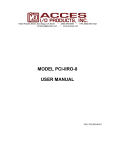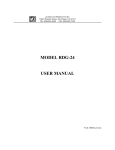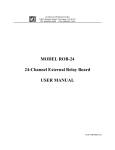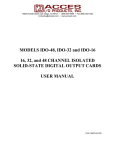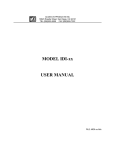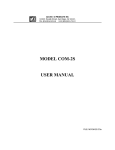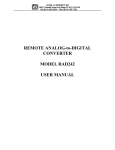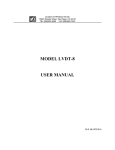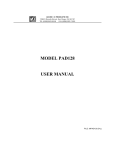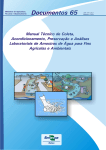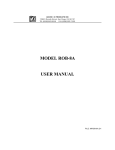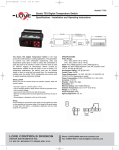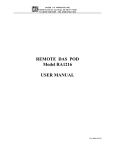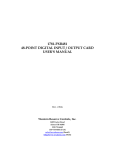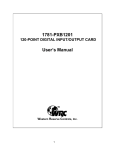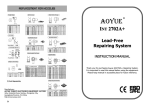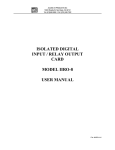Download Datasheet
Transcript
Remote Serial Interface Pod
RDI-54
User Manual
NOTICES
The information in this document is provided for reference only. Portwell I/O PRODUCTS
INC does not assume any liability arising out of the application or use of the information
or products described herein. This document may contain or reference information and
products protected by copyrights or patents and does not convey any license under the
patent rights of Portwell, nor the rights of others.
Printed in USA. Copyright All rights reserved.
i
Remote Serial Interface Pod
RDI-54
User Manual
TABLE OF CONTENTS
INSTALLATION . . . . . . . . . . . . . . . . . . . . . . . . . . . . . . . . . . . . . . . . . . . . . . . . . . . . . . . . . . . . . . . . .
INSTALLING THE SOFTWARE . . . . . . . . . . . . . . . . . . . . . . . . . . . . . . . . . . . . . . . . . . . . . .
INSTALLING THE POD . . . . . . . . . . . . . . . . . . . . . . . . . . . . . . . . . . . . . . . . . . . . . . . . . . . .
PIN CONNECTIONS . . . . . . . . . . . . . . . . . . . . . . . . . . . . . . . . . . . . . . . . . . . . . . . . . . . . . .
1-1
1-1
1-4
1-3
FUNCTIONAL DESCRIPTION . . . . . . . . . . . . . . . . . . . . . . . . . . . . . . . . . . . . . . . . . . . . . . . . . . . . .
FEATURES . . . . . . . . . . . . . . . . . . . . . . . . . . . . . . . . . . . . . . . . . . . . . . . . . . . . . . . . . . . . .
DESCRIPTION . . . . . . . . . . . . . . . . . . . . . . . . . . . . . . . . . . . . . . . . . . . . . . . . . . . . . . . . . . .
BLOCK DIAGRAM . . . . . . . . . . . . . . . . . . . . . . . . . . . . . . . . . . . . . . . . . . . . . . . . . . . . . . . .
2-1
2-1
2-1
2-2
SOFTWARE . . . . . . . . . . . . . . . . . . . . . . . . . . . . . . . . . . . . . . . . . . . . . . . . . . . . . . . . . . . . . . . . . . .
GENERAL . . . . . . . . . . . . . . . . . . . . . . . . . . . . . . . . . . . . . . . . . . . . . . . . . . . . . . . . . . . . . .
Command Structure . . . . . . . . . . . . . . . . . . . . . . . . . . . . . . . . . . . . . . . . . . . . . . . . .
Addressed Mode . . . . . . . . . . . . . . . . . . . . . . . . . . . . . . . . . . . . . . . . . . . . . . . . . . .
Non-Addressed Mode . . . . . . . . . . . . . . . . . . . . . . . . . . . . . . . . . . . . . . . . . . . . . . . .
Command List . . . . . . . . . . . . . . . . . . . . . . . . . . . . . . . . . . . . . . . . . . . . . . . . . . . .
COMMAND FUNCTIONS . . . . . . . . . . . . . . . . . . . . . . . . . . . . . . . . . . . . . . . . . . . . . . . . . . .
Set Time Base . . . . . . . . . . . . . . . . . . . . . . . . . . . . . . . . . . . . . . . . . . . . . . . . . . . . .
Read Digital Inputs . . . . . . . . . . . . . . . . . . . . . . . . . . . . . . . . . . . . . . . . . . . . . . . . . .
Read Change-of-State . . . . . . . . . . . . . . . . . . . . . . . . . . . . . . . . . . . . . . . . . . . . . . .
Enable Change-of-State Detection . . . . . . . . . . . . . . . . . . . . . . . . . . . . . . . . . . . . . .
Selecting Which Edge Will Increment Counter . . . . . . . . . . . . . . . . . . . . . . . . . . . . .
Read Digital Input Counter . . . . . . . . . . . . . . . . . . . . . . . . . . . . . . . . . . . . . . . . . . . .
Reset Counter . . . . . . . . . . . . . . . . . . . . . . . . . . . . . . . . . . . . . . . . . . . . . . . . . . . . .
Read Firmware Revision Number . . . . . . . . . . . . . . . . . . . . . . . . . . . . . . . . . . . . . . .
Resend Last Response . . . . . . . . . . . . . . . . . . . . . . . . . . . . . . . . . . . . . . . . . . . . . . .
Hello Message . . . . . . . . . . . . . . . . . . . . . . . . . . . . . . . . . . . . . . . . . . . . . . . . . . . . .
Setting a New Baud Rate . . . . . . . . . . . . . . . . . . . . . . . . . . . . . . . . . . . . . . . . . . . . .
Programming Pod Address . . . . . . . . . . . . . . . . . . . . . . . . . . . . . . . . . . . . . . . . . . . .
Entering a New Program . . . . . . . . . . . . . . . . . . . . . . . . . . . . . . . . . . . . . . . . . . . . .
ERROR CODES: . . . . . . . . . . . . . . . . . . . . . . . . . . . . . . . . . . . . . . . . . . . . . . . . . . . . . . . . .
3-1
3-1
3-1
3-1
3-2
3-2
3-2
3-2
3-3
3-3
3-4
3-5
3-5
3-5
3-6
3-6
3-6
3-7
3-8
3-8
3-9
SPECIFICATIONS . . . . . . . . . . . . . . . . . . . . . . . . . . . . . . . . . . . . . . . . . . . . . . . . . . . . . . . . . . . . . .
SERIAL COMMUNICATIONS INTERFACE . . . . . . . . . . . . . . . . . . . . . . . . . . . . . . . . . . . . .
DIGITAL INPUTS . . . . . . . . . . . . . . . . . . . . . . . . . . . . . . . . . . . . . . . . . . . . . . . . . . . . . . . . .
ENVIRONMENTAL . . . . . . . . . . . . . . . . . . . . . . . . . . . . . . . . . . . . . . . . . . . . . . . . . . . . . . . .
POWER REQUIRED . . . . . . . . . . . . . . . . . . . . . . . . . . . . . . . . . . . . . . . . . . . . . . . . . . . . . .
4-1
4-1
4-1
4-1
4-2
WARRANTY . . . . . . . . . . . . . . . . . . . . . . . . . . . . . . . . . . . . . . . . . . . . . . . . . . . . . . . . . . . . . . . . . . . 5-1
APPLICATION CONSIDERATIONS . . . . . . . . . . . . . . . . . . . . . . . . . . . . . . . . . . . . . . . . . . . . . . . . . A-1
ii
Remote Serial Interface Pod
RDI-54
User Manual
INSTALLATION
INSTALLING THE SOFTWARE
You have received with your product a CD that contains all the software you need to use
your card. The CD is compatible with any type of Windows or DOS system.
To install the software required for your card:
1.
Insert CD in your CD ROM - If the install program does not start within 30
seconds, run “install.exe”from the root directory of the CD.
2.
Click the Install Software to Hard Disk button.
3.
Select the product you wish to install from the list shown.
4.
Click Next.
5.
The CD creates a directory with a default name; if you want to change it,
click Change and select the path you prefer.
6.
We advise you to also install the Tools Package at least once per system.
7.
Click Quick Install to run the install process or click Detailed Install if you
want more information on the files installed.
8.
Click Finish.
9.
Click Exit install program when finished.
You now have two types of files on your hard disk:
1. Software, including samples in C, Pascal, QuickBasic and a setup program, specifically
for your card.
2. Software to help you use Portwell cards under a variety of environments:
Setup.exe
Setup program
Findbase.exe
DOS utility to determine an available base address for ISA bus , non-PnP
cards. Run this program once, before the hardware is installed in the
computer, to determine an available address to give the card. Once the
address has been determined, run the setup program provided with the
hardware to see instructions on setting the address switch and various
option selections.
Poly.exe
A generic utility to convert a table of data into an nth order polynomial.
Useful for calculating linearization polynomial coefficients for
1-1
Remote Serial Interface Pod
RDI-54
User Manual
thermocouples and other non-linear sensors.
Risc.bat
A batch file demonstrating the command line parameters of RISCTerm.exe.
RISCTerm.exe
A dumb-terminal type communication program designed for RS422/485
operation. Used primarily with REMOTE Portwell data acquisition Pods
and our RS422/485 serial communication product line. Can be used to say
hello to an installed modem. RISCTerm stands for Really Incredibly Simple
Communications TERMinal
In the ACCES32
directory:
This directory contains the Windows 95/98/NT driver used to provide
access to the hardware registers when writing 32-bit Windows software.
Several samples are provided in a variety of languages to demonstrate
how to use this driver. The DLL provides four functions (InPortB,
OutPortB, InPort, and OutPort) to access the hardware.
This directory also contains the device driver for NT. This device driver
provides register-level hardware access from Windows NT, normally called
through ACCES32.DLL. Two methods of using the driver are provided, the
ACCES32.DLL (recommended) and the DeviceIOControl handles direct to
the SYS file (slightly faster)
ACCES95 and ACCESNT
These two drivers are mentioned for users migrating from older versions of
Portwell Tools. The functionality of ACCES95 and ACCESNT has been
combined into ACCES32.DLL, which is described up
.
In order to modify your software to use the new ACCES32.DLL, change the
file you link to from ACCES95 or ACCESNT to ACCES32. No other changes
are necessary.
If you want to avoid recompiling software that was written for ACCES95 or
ACCESNT, just rename ACCES32.DLL to the appropriate name (95 or NT).
In the BSAMPLES
directory:
A Quickbasic sample.
In the CSAMPLES
directory:
In the PCI
directory:
In the PSAMPLES
directory:
Samples in C.
This directory contains PCI-bus specific programs and information. If you
are not using an Portwell PCI card, you can ignore or delete this directory.
This directory contains samples in Pascal
1-2
Remote Serial Interface Pod
In the VBACCES
directory:
In the WIN32IRQ
directory:
RDI-54
User Manual
Sixteen-bit DLL drivers for use with VisualBASIC 3.0 and Windows 3.1 only.
These drivers provide four functions, similar to the ACCES32 DLL.
However, this DLL is only compatible with 16-bit executables. Migration
from 16-bit to 32-bit is simplified because of the similarity between
VBACCES and ACCES32.
you have utility software to handle IRQs from any card under Win95/98 or
NT
1. Drivers.src with 3 subdirectories
a. DLL
Samples for using ACCES32.DLL are provided in this directory.
Using this DLL not only makes the hardware programming easier
(MUCH easier), but also one source file can be used for both
Windows 95/98 and WindowsNT. One executable can run under
both operating systems and still have full access to the hardware
registers. The DLL is used exactly like any other DLL, so it is
compatible with any language capable of using 32-bit DLLs. Consult
the manuals provided with your language’s compiler for information
on using DLLs in your specific environment.
b. SYS
The samples in this directory are provided ONLY for WindowsNT.
The DeviceIOControl based interaction with the register-level driver
is only available in NT. If your code is written to use this method, it
will not work with Windows 95 or Windows 98.
The SYS file is the actual workhorse behind hardware access in
WindowsNT. It utilizes the DeviceIOControl API function for
interaction with user code. Samples are provided demonstrating this
API call, but it is strongly recommended that the DLL interface be
used. The DLL described above encapsulates the SYS file and
performs the DeviceIOControl calls at a small penalty in speed. (A
call through the DLL interface)
c. VXD
source fo the driver
2. Samples: Samples in VisualC, Delphi and C++ Builder
1-3
Remote Serial Interface Pod
RDI-54
User Manual
INSTALLING THE POD
The RDI-54 enclosure is a sealed, die-cast aluminum-alloy NEMA-4 enclosure that can be
easily mounted. Outside dimensions of the enclosure are: 4.53" long by 3.54" wide by
2.17" high. The cover incorporates a recessed neoprene gasket and the cover is secured
to the body by four recessed M-4, stainless steel, captive screws. Two long M-3.5 X 0.236
screws are provided for mounting the body. Mounting holes and cover-attaching screws
are outside the sealed area to prevent ingress of moisture and dust. Four threaded bosses
inside the enclosure provide for mounting the printed circuit card assemblies.
A screw terminal assembly is provided for electrical connections inside the pod. You can
make these connections by assembling a cable of whatever length you need. At the other
end you can either assemble a 62-pin connector to mate with a header on your termination
panel (for ease of connect/disconnect) or whatever termination method best fits your
application.
If you desire, Portwell can provide a custom cable fabricated according to your
specifications.
(Continued on next page)
1-4
Remote Serial Interface Pod
RDI-54
User Manual
PIN CONNECTIONS
Connections to RDI-54 are made at a screw terminal assembly located at the top of the
module. Screw terminal numbers silk-screened on that card and the corresponding signals
are as follows:
Term. #
Signal
Term.#
Signal
1
2
3
4
5
6
7
8
9
10
11
12
13
14
15
16
17
18
19
20
21
22
23
24
25
26
27
28
29
30
31
Bit 5 ***
Bit 4
Bit 3
Bit 2
Bit 33
Bit 34
Bit 35
Bit 39
Bit 38
Bit 8
Bit 9
Bit 10
Bit 11
Bit 13
Bit 12
Bit 14
Bit 15
Bit 37
Bit 36
Bit 40
Bit 41
Bit 42
Bit 43
Bit 47
Bit 46
Bit 45
Bit 44
Bit 16
Bit 17
Bit 51
Bit 48
32
33
34
35
36
37
38
39
40
41
42
43
44
45
46
47
48
49
50
51
52
53
54
55
56
57
58
59
60
61
62
Bit 53
Bit 52
Bit 6
Bit 7
Bit 1
Bit 0
Bit 24
Bit 25
Bit 26
Bit 27
Bit 31
Bit 30
Bit 29
Bit 28
Bit 32
Bit 18
Bit 19
Bit 20
Bit 21
Bit 22
Bit 23
Reset
RS485+
RS485/INT0
Local Pwr *
Local Pwr Gnd
Isolator Pwr **
Isolator Pwr Gnd
Bit 50
Bit 49
Notes:
*
“Local” Power is power from a local power supply. The voltage can be anywhere
from 7.5 VDC to 16 VDC. Higher local power, 24 VDC for example, can be used if
an external zener diode is used to reduce the voltage applied to RDI-54. ( S e e
Temperature de-rating comments in the Specification section of this manual under
“Power Required”.)
1-5
Remote Serial Interface Pod
RDI-54
User Manual
**
“Isolator” Power is used by the opto-isolator section of RDI-54 and should be
independent of “Local Power”. Isolator power should be connected between
terminals 59 and 60. That power can be the computer's +12V supply (via the serial
communications cable) or from an isolated local power supply. The power level can
be from 7.5 to 35 VDC and the isolator section will require only 7 mA of current. If
a separate power supply is not available, then, with loss of some isolation, these
isolator power terminals can be connected to the local power terminals. Regardless
of isolation mode selected via the ISO/ISO jumpers, power must be applied to these
pins for serial communication to function.
***
Digital Inputs are protected by series resistors. There are no onboard pull-up or
pull-down resistors on the inputs. An unconnected input will be a floating logic level
and its state can not be guaranteed.
To ensure that there is minimum susceptibility to EMI and minimum radiation, it is important
that there be a positive chassis ground. Also, proper EMI cabling techniques (cable
connect to chassis ground at the aperture, twisted pair wiring, and, in extreme cases,
ferrite-level of EMI protection) must be used on input/output wiring.
CE-marked versions of RDI-54 meet the requirements of EN50081-1:1992 (Emissions),
EN50082-1:1992 (Immunity), and EN60950:1992 (Safety).
1-6
Remote Serial Interface Pod
RDI-54
User Manual
FUNCTIONAL DESCRIPTION
FEATURES
*
*
*
*
*
*
*
*
Opto-Isolated RS-485 Serial Interface to Host Computer.
54 Digital Inputs
Digital Input Voltages up to 50V.
NEMA4 Enclosure for Harsh Atmospheric or Marine Environments.
Type 8031 Microcontroller with 8K RAM and 8K EEPROM. (32K X 8
optional)
All Programming in Software, No Switches or Jumpers to Set.
8-Bit Digital Input Software Counters.
Change of State Flag Readable via the Serial Port.
DESCRIPTION
RDI-54 is an intelligent interface unit that connects up to 54 parallel digital inputs to a
computer. It is packaged in a NEMA4 enclosure for remote installation in harsh
environments. Communication with the host computer is via EIA RS-485 half-duplex, serial
communications protocol. ASCII-based command/response protocol permits communication
with virtually any computer system. RDI-54 is one of a series of remote intelligent units
called the “REMOTE Portwell” series. As many as 31 REMOTE Portwell Series pods (or
other RS-485 devices) may be connected to the computer on a single two-wire multidrop
RS-485 network.
A type 8031 microcontroller (with 8Kx8 RAM, 8Kx8 non-volatile EEPROM, and a watchdog
timer circuit) gives RDI-54 the capability and versatility expected from a modern distributed
control system. To accomodate special programs, the RAM and EEPROM can each be
expanded to 32K x 8. The unit contains CMOS low-power circuitry, an optically-isolated
receiver/transmitter, and power conditioners for local and external isolated power. It can
operate at baud rates up to 57.6 Kbaud at distances up to 5000 feet with low-attenuation
twisted-pair cabling.
All programming of RDI-54 is in ASCII-based software and there are no switches or jumpers
to set. (One exception to the foregoing is that you have the option of by-passing the
optoisolators by re-locating three jumpers.) Use of ASCII-based software permits you to
write applications in any high-level language that supports ASCII string functions and you
can use REMOTE Portwell series modules with virtually any computer.
The module, or pod, address is programmable from 00 to FF hex and whatever address is
assigned is stored in EEPROM and used as the default address at the next Power-ON.
Similarly, the baud rate is programmable for 1200, 2400, 4800, 9600, 14400, 19200, 28800,
and 57600 and is stored in EEPROM and used as default at the next Power-ON.
The time base, used in all time-relevant operations is also software selectable to
2-1
Remote Serial Interface Pod
RDI-54
User Manual
provide digital-input sample rates from 14 Hz to 1 KHz
Digital inputs of up to 50V amplitude may be read individually, or in 8-bit bytes. There are
also digital input counters on each input. Selectable edges can be counted for up to 255
transitions. These counters support Read and Reset commands. Moreover, change-ofstate flags can be set on any enabled input bits and can be read via the serial port. This
is particularly useful in applications where it’s necessary to detect contact closures or
openings. This change-of-state detection capability is enabled on a bit-by-bit basis for all
input bits.
BLOCK DIAGRAM
The built-in watchdog timer resets the pod if, for some unexpected reason, the
microcontroller “hangs up”. Data collected by the pod can be stored in local RAM and
accessed later through the computer's serial port. This facilitates a stand-alone pod mode
of operation.
2-2
Remote Serial Interface Pod
RDI-54
User Manual
SOFTWARE
GENERAL
You received ASCII-based software on CD for use with RDI-54. ASCII programming
permits you to write applications in any high level language that supports ASCII string
functions.
The communication protocol has two forms: addressed and non-addressed. Nonaddressed protocol can be used when only one RDI-54 is in use. When more than one
module (pod) is in use, addressed protocol must be used. The only difference is that an
address command is sent to enable the specific pod. The address command is only sent
once during communication between the pod and the host computer. It enables
communication with that specific pod and disables all other pods on the network.
Command Structure
All communication must be 7 data bits, even parity, 1 stop bit. All numbers sent to or
received from the pod are in hexadecimal form. The factory default baud rate is 9600 Baud.
The pod is considered to be in addressed mode any time its pod address is not 00. The
factory default pod address is 00 (non-addressed mode).
Addressed Mode
The address select command must be issued before any other command to the addressed
pod. The address command is as follows:
“!xx[CR]” where xx is the pod address from 01 to FF hex, and [CR] is Carriage
Return, ASCII character 13.
The pod responds with “xxN[CR]”or “xxY[CR]”if an input change of state has occurred on
enabled bits since the last “Y”or address command, or with “xxN[CR]”otherwise.
Once the address select command has been issued, all further commands (other than a
new address select) will be executed by the selected pod. The addressed mode is required
when using more than one pod.
Non-Addressed Mode
When there’s only one pod connected, no address select command is needed. You can
merely issue commands listed in the following table. Terminology used is as follows:
a. The single lower case letter ‘x’designates any valid hex digit (0-F).
b. The single lower case letter ‘b’designates either a ‘1' or ‘0'.
c. The single lower case letter 'p' designates eight-bit port.
3-1
Remote Serial Interface Pod
RDI-54
User Manual
d. The symbol ‘±’designates either a ‘+’or a ‘-’.
e. All commands are terminated with CR, the ASCII character #13.
f. Wherever xx is used to designate a bit number, only 00-35 are valid.
g. All commands are case insensitive; i.e., can be either upper case or lower case
.
h. The symbol ‘*’means zero or more valid characters (total msg length <255 .
decimal)
Command List
Sxxxx
Set a new timebase. 039A<xxxx<=FFFF
CR
I
Read all digital bits.
xxxxxxCR
Ixx
Read a single digital bit. (00<=xx<=35)
bCR
Ip
Read digital bits (p*8 through p*8+7) 0<=p<=6
xxCR
Y
Read digital input COS bit and clear bit
Y or N
Tpxx
Set bit (p*8) - (p*8+7) Mask for COS bit flag, 0=ignore COS
CR
Dx±
Set digital input active state high or low on bit x
CR
Dxx±
Set digital input active state high or low on bit xx
CR
Cxx
Read digital input xx counter (counts each active pulse)
xxCR
Rxx
Reset digital input counter xx to 00
CR
Rall
Reset all digital input counters
CR
V
Read the Firmware version number
x.xxCR
N
Resend last response
varies
H*
Greeting message: copyright, firmware version number
varies
BAUD=xxx Set new baud rate. Each x is code number for new baud =:Baud:0x
POD=xx Set pod address to xx
varies
PROGRAM= Begin process of uploading custom program to pod
special
D
Download historical storage of digital input data again
varies
COMMAND FUNCTIONS
The following paragraphs give details of the command functions, describe what the
commands cause, and give examples. Please note that all commands have an
acknowledgement response. You must wait for a response from a command before another
command is sent.
Set Time Base
Sxxxx
Set Time Base
This function sets the pod-global timebase which is used in all time-sensitive operations.
Valid values range from 039A to FFFF. Any invalid value will result in the pod-default
timebase of 2400 (10ms/100Hz).
039A corresponds to 1KHz, 2400 is 100Hz, and the longest timebase of FFFF corresponds
to 14Hz. (11,059,200Hz / 12 / timebase = Hz rate of time base)
Examples:
3-2
Remote Serial Interface Pod
RDI-54
User Manual
Program the RDI-54 to a 1msec timebase
SEND:
S039A
RECEIVE:
[CR]
NOTE: The timebase configured is stored in EEPROM on the pod, and will be used as the
default (power-on) timebase. The factory default timebase (100Hz) can be restored
by sending "S0000" to the pod.
Read Digital Inputs
I
Ixx
Ip
Read 54 bits
Read bit number xx
Read bits (p*8) through (p*8+7)
These commands read the digital input bits from the pod. All byte or word wide responses
are sent most-significant nibble first.
Examples:
Read all 54 bits.
SEND:
RECEIVE:
I
FFFFFFFFFFFFFF[CR]
Read only bit 35 (53 decimal, the highest bit on the card)
SEND:
I35
RECEIVE:
1[CR]
Read only bit 2
SEND:
RECEIVE:
Read bits 8-F
SEND:
RECEIVE:
I02
1[CR]
I1
FF[CR]
Read Change-of-State
Y
Read COS bit.
The pod can set a change-of-state flag for any input that has been configured to do so.
This command will read then reset that bit. Therefore, this command will always return
“N[CR]” unless the T command has first been used to enable change-of-state detect for
any given bit.
If a change-of-state has been detected since the last “Y”command (see note), the pod will
return “Y[CR]”otherwise “N[CR]”will be returned.
Example:
3-3
Remote Serial Interface Pod
Read COS bit
SEND:
RECEIVE:
RDI-54
User Manual
Y
N[CR]
NOTE: The address command for any given pod will also return “Y”or “N”and clear the
Change-of-state flag in the pod.
Enable Change-of-State Detection
Tpxx
Set COS mask for bits (p*8) through (p*8+7)
These commands configure the bit-by-bit mask to enable change-of-state to set the COS
flag on the pod for readback by the “Y” or address commands. If a one is set for a
particular bit, that bit will set the COS flag if/when the bit changes state. A zero will disable
change-of-state detection.
Examples:
Allow bit 13 and only bit 13 to set the COS flag
SEND:
T000
RECEIVE:
[CR]
SEND:
T100
RECEIVE:
[CR]
SEND:
T208
RECEIVE:
[CR]
SEND:
T300
RECEIVE:
[CR]
SEND:
T400
RECEIVE:
[CR]
SEND:
T500
RECEIVE:
[CR]
SEND:
T600
RECEIVE:
[CR]
Allow a change of state on ANY bit to set the COS flag
SEND:
T0FF
RECEIVE:
[CR]
SEND:
T1FF
RECEIVE:
[CR]
SEND:
T2FF
RECEIVE:
[CR]
etc...
NOTE: The COS Flag is read via either the “Y” command or a valid address command.
The COS Flag is reset to FALSE by either command.
Selecting Which Edge Will Increment Counter
3-4
Remote Serial Interface Pod
RDI-54
dx±
dxx±
User Manual
Set Digital input active state on bit x
Set Digital input active state on bit xx
These commands allow you to set whether a rising or falling edge will increment the digital
input counter; i.e., if all bits are set to rising edge, the digital input counter for any given
bit will increment each time a rising edge is detected. “+”is rising edge, “-”is falling edge.
Examples:
Set bit 1 to rising edge active
SEND:
D1+
or
SEND:
RECEIVE:
D01+
[CR]
Set bit 35 to falling edge active
SEND:
RECEIVE:
D35[CR]
NOTE: The digital input counters are read with the “cxx”command, and reset with the “rxx”
command.
Read Digital Input Counter
cxx
Read digital input counter xx
This command will read how many times bit xx has changed to its active state (as
configured with dx± or dxx±) since the last reset command (rxx). Input counters are
configured as 8-bit counters. Counter content is provided most significant bit first.
Example:
Read digital input counter for bit #1
SEND:
C01
RECEIVE:
13[CR]
;assuming 13hex edges since last reset
Reset Counters
rxx
rall
Reset digital input counter xx
Reset all digital input counters
These commands are used to reset digital input counters to zero.
Example:
Reset digital input counter for digital input number 3
SEND:
r03
RECEIVE:
[CR]
Read Firmware Revision Number
3-5
Remote Serial Interface Pod
V
RDI-54
User Manual
Read the firmware revision number
This command is used to read the version of firmware installed in the pod. It returns
“X.XX[CR]”.
Example:
Read the RDI-54 version number
SEND:
V
RECEIVE: 1.00[CR]
NOTE: The “H”command returns the version number along with other information.
Resend Last Response
n
Resend last response
This command will cause the pod to return the same thing it just sent. This command
works for all responses less than 255 characters in length. Normally this command is used
if the host detected a parity or other line fault while receiving data, and needs the data to
be sent a second time.
The “n”command may be repeated.
Example:
Assuming that the last command was “I”, ask pod to resend last response
SEND:
RECEIVE:
n
FFFFFFFFFFFFFF[CR];or whatever the data was
Hello Message
H*
Hello message
Any string of characters starting with “H” will be interpreted as this command. (“H[CR]”
alone is also acceptable.) The return from this command takes the form (without the
quotes):
“=Pod aa, RIOD-24 Rev rr Firmware Ver:x.xx Portwell I/O Products, Inc.”
aa is the pod address
rr is the hardware revision, such as “B1"
x.xx is the software revision, such as “1.00"
Example:
Read the greeting message
SEND:
Hello?
3-6
Remote Serial Interface Pod
RDI-54
RECEIVE:
User Manual
=Pod 00, RDI-54 Rev B1 Firmware Ver:1.00
Portwell I/O Products, Inc.[cr]
Setting a New Baud Rate
BAUD=xxx
Program the pod with a new baud rate
This command sets the pod to communicate at a new baud rate. The parameter passed,
xxx, is slightly unusual. Each x is the same digit from the following table:
CODE
BAUD
0
1200
1
2400
2
4800
3
9600
4
14400
5
19200
6
28800
7
57600
Therefore, valid values for the command’s xxx are 000, 111, 222, 333, 444, 555, 666, or
777.
The pod returns a message indicating it will comply. The message is sent in the old baud
rate, not the new one. Once the message is transmitted, the pod changes to the new baud
rate. The new baud rate is stored in EEPROM and will be used even after power-reset,
until a new “BAUD=xxx”command is issued.
Example:
Set the pod to 19200 baud
SEND:
RECEIVE:
BAUD=555
=:Baud:05[CR]
Set the pod to 9600 baud
SEND:
RECEIVE:
BAUD=333
=:Baud:03[CR]
Programming Pod Address
POD=xx
Program the currently selected pod to respond at
address xx
3-7
Remote Serial Interface Pod
RDI-54
User Manual
This command changes the pod’s address to xx. If the new address is 00, the pod will be
placed into non-addressed mode. If the new address is not 00, the pod will not respond
to further communications until a valid address command is issued. Hex numbers 00-FF
are considered valid addresses. The RS485 specification allows only 32 drops on the line,
so many addresses will be unused.
The new pod address is saved in EEPROM and will be used even after power-down until
the next “POD=xx”command is issued. Note that, if the new address is not 00 (i.e., the
pod is configured to be in addressed mode), it is necessary to issue an address command
to the pod at the new address before it will respond.
The pod returns a message containing the pod number as confirmation.
Example:
Set the pod address to 01
SEND:
RECEIVE:
A=01
=:Pod#01[CR]
Set the pod address to F3
SEND:
RECEIVE:
A=F3
=:Pod#F3[CR]
Take the pod out of addressed mode
SEND:
A=00
RECEIVE:
=:Pod#00[CR]
Entering a New Program
PROGRAM= This command initiates the transfer of a new
program to the RDI-54.
This command should be used carefully. If you accidentally issue a “PROGRAM=”
command, ESC (ASCII 27) will restart the pod as if power had been reset.
This feature is designed to allow Portwell to provide field-upgrades to the RDI-54 firmware,
and, for advanced users, the opportunity to customize the firmware in the pod.
Documentation relating to the use of this command is provided with the upgrade CD, or
is available separately for a small fee.
3-8
Remote Serial Interface Pod
RDI-54
User Manual
ERROR CODES:
The following error codes can be returned from the pod:
1:
Invalid channel number (too large, or not a number. All channel
numbers must be between 00 and 35, in hex. (0-54 decimal))
3:
Improper Syntax. (Not enough parameters is the usual culprit)
4:
Channel number is invalid for this task
9:
Parity error. (This occurs when some part of the received data
contains a parity or framing error)
Additionally, several full-text error codes are returned. All begin with “Error, ”, and are
useful when using a terminal to program the pod.
Error, Unrecognized Command: {command received}[CR]
This occurs if the command is not recognized.
Error, Command not fully recognized: {Command received}[CR]
This occurs if the first letter of the command is valid, but the remaining letters are not.
Error, Address command must be CR terminated[CR]
This occurs if the address command (!xx[CR]) has extra characters between the pod
number and the [CR].
3-9
Remote Serial Interface Pod
RDI-54
User Manual
SPECIFICATIONS
SERIAL COMMUNICATIONS INTERFACE
Serial Port: Opto-isolated Matlabs type LTC485 Transmitter/Receiver. Compatible with
RS-485 specification. Up to 32 drivers and receivers allowed on line. Pod I/O bus
programmable from 00 to FF hex (0-255 decimal). Whatever address is assigned
is stored in EEPROM and used as default at next Power-On.
Input Common Mode Voltage: 300V minimum (opto-isolated). If opto-isolators are bypassed: -7V to +12V.
Receiver Input Sensitivity: ±200 mV, differential input.
Receiver Input Impedance: 12K? minimum
Transmitter Output Drive Capability: 60 mA, 100 mA short-circuit current capability.
Serial Data Rates: Programmable for 1200, 2400, 4800, 9600, 14400, 19200, 28800, and
57600 baud. Crystal oscillator provided.
DIGITAL INPUTS
Number: Up to 54. Can be read on a bit-by-bit basis, or an 8-bit byte basis, or all 54 at
once..
Sample Rate: Programmable from 14 Hz to 1 KHz.
Software Counters: There are 8-bit software counters on all bits programmed to be inputs.
These can be programmed to increment on either rising or falling edges.
Change of State Detection: Change-of-state flags can be set on any enabled input bits
and can be read via the serial port.
Logic Input Low: -0.5V to +0.8V.
Logic Input High: +2.0V to +50.0V
Low-level Input Current: 450 ? A maximum.
ENVIRONMENTAL
Operating Temperature Range: 0o TO 65oC (Optional -40?to +80?C.). See box below for
temperature de-rating based on power voltage applied.
4-1
Remote Serial Interface Pod
RDI-54
User Manual
The power supply voltage level that you use will affect the maximum ambient
temperature that can be tolerated. At higher power levels more heat will be
generated by integral voltage regulators. (For example, when 7.5 VDC is
applied, the temperature rise inside the enclosure is 7.3OC above the ambient
temperature.) Thus, the maximum allowable ambient temperature may be
reduced when power supply voltages greater than 7.5 VDC are used.
The equation to use to determine temperature de-rating is:
VI(TJ = 120) < 22.5 - 0.2 TA
where TA is the ambient temperature in OC and VI(TJ + 120) is the input voltage at
which the voltage regulator junction temperature will rise to a temperature of
120O. (Note: The maximum junction temperature rating of the voltage regulator
used is 150O, so limiting to 120O provides a safety margin.)
For example, at an ambient temperature of 25O, the voltage VI can be up to
18.4V. At an ambient temperature of 100O, the voltage can be up to 16.6V.
Storage Temperature Range: -50?to +120?C.
Humidity: 5% to 95% non-condensing. Enclosure is designed to meet NEMA4
requirements.
Size: NEMA4 enclosure 4.53" long by 3.54" wide by 2.17" high.
POWER REQUIRED
Power for the opto-isolated section can be applied from the computer's +12 VDC power
supply via the serial communication cable. Power for the rest of the pod can be supplied
by a local power supply.
Opto-Isolated Section: 7.5 to 25 VDC @ 40 mA. (Note: Due to the small amount
of current required, voltage drop in the communication
cable will be inconsequential.)
Local Power: 7.5 to 16 VDC @ 100 mA. See box below.
4-2
Remote Serial Interface Pod
RDI-54
If the local power supply has an output voltage greater than
16VDC, you can install a zener diode in series with the supply
voltage. The voltage rating of the zener diode (VZ) should be
equal to VI - 16 where VI is the power supply voltage. The
voltage rating of the zener diode should be ? VZ x 0.12 watts.
Thus, for example, a 24 VDC power supply would require use of
an 8.2V zener diode with a power rating of 8.2 x 0.12 ? 1 watt
4-3
User Manual
Remote Serial Interface Pod
RDI-54
User Manual
WARRANTY
Prior to shipment, Portwell products are thoroughly inspected and tested to applicable
specifications. However, should equipment failure occur, Portwell assures its customers
that prompt service and support will be available. All equipment originally manufactured
by Portwell which is found to be defective will be repaired or replaced subject to the
following considerations.
TERMS AND CONDITIONS
If a unit is suspected of failure, contact Portwell' Customer Service department. Be prepared
to give the model number, serial number, and a description of the failure symptom(s). We
may suggest some simple tests to confirm the failure. We will assign a Return Material
Authorization (RMA) number which must appear on the outer label of the return package.
All units/components should be properly packed for handling and returned, freight prepaid,
to the Portwell designated Service Center, and will be returned to the customer's/user's site
freight prepaid and invoiced.
COVERAGE
First Three Years: Returned unit/part will be repaired and/or replaced at Portwell option
with no charge for labor or parts not excluded by warranty. Warranty commences with
equipment shipment.
Following Years: Throughout your equipment's lifetime, Portwell stands ready to provide
on-site or in-plant service at reasonable rates similar to those of other manufacturers in the
industry.
EQUIPMENT NOT MANUFACTURED BY Portwell
Equipment provided but not manufactured by Portwell is warranted and will be repaired
according to the terms and conditions of the respective equipment manufacturer's warranty.
GENERAL
Under this Warranty, liability of Portwell is limited to replacing, repairing or issuing credit (at Portwell
discretion) for any products which are proved to be defective during the warranty
period. In no case is Portwell liable for consequential or special damage arising from use
or misuse of our product. The customer is responsible for all charges caused by
modifications or additions to Portwell equipment not approved in writing by Portwell or, if in Portwell
opinion the equipment has been subjected to abnormal use. "Abnormal use" for
purposes of this warranty is defined as any use to which the equipment is exposed other
than that use specified or intended as evidenced by purchase or sales representation.
Other than the above, no other warranty, expressed or implied, shall apply to any and all
such equipment sold or furnished by Portwell.
5-1
Remote Serial Interface Pod
RDI-54
User Manual
APPENDIX A
APPLICATION CONSIDERATIONS
INTRODUCTION
Working with RS-422 and RS-485 devices is not much different from working with standard
RS-232 serial devices and these two standards overcome deficiencies in the RS-232
standard. First, the cable length between two RS-232 devices must be short; less than 50
feet at 9600 baud. Second, many RS-232 errors are the result of noise induced on the
cables. The RS-422 standard permits cable lengths up to 5000 feet and, because it
operates in the differential mode, it is more immune to induced noise.
Connections between two RS-422 devices (with CTS ignored) should be as follows:
Device #1
Device #2
Signal
Pin No.
Signal
Pin No.
Gnd
TX+
TXRX+
RX-
7
24
25
12
13
Gnd
RX+
RXTX+
TX-
7
12
13
24
25
A third deficiency of RS-232 is that more than two devices cannot share the same cable.
This is also true for RS-422 but RS-485 offers all the benefits of RS-422 plus allows up to
32 devices to share the same twisted pairs. An exception to the foregoing is that multiple
RS-422 devices can share a single cable if only one will talk and the others will all receive.
BALANCED DIFFERENTIAL SIGNALS
The reason that RS-422 and RS-485 devices can drive longer lines with more noise
immunity than RS-232 devices is that a balanced differential drive method is used. In a
balanced differential system, the voltage produced by the driver appears across a pair of
wires. A balanced line driver will produce a differential voltage from ±2 to ±6 volts across
its output terminals. A balanced line driver can also have an input “enable” signal that
connects the driver to its output terminals. If the “enable signal is OFF, the driver is
disconnected from the transmission line. This disconnected or disabled condition is usually
referred to as the “tristate”condition and represents a high impedance. RS-485 drivers must
have this control capability. RS-422 drivers may have this control but it is not always
required.
A-1
Remote Serial Interface Pod
RDI-54
User Manual
A balanced differential line receiver senses the voltage state of the transmission line across
the two signal input lines. If the differential input voltage is greater than +200 mV, the
receiver will provide a specific logic state on its output. If the differential voltage input is less
than -200 mV, the receiver will provide the opposite logic state on its output. A maximum
operating voltage range is from +6V to -6V allows for voltage attenuation that can occur on
long transmission cables.
A maximum common mode voltage rating of ±7V provides good noise immunity from
voltages induced on the twisted pair lines. The signal ground line connection is necessary
in order to keep the common mode voltage within that range. The circuit may operate
without the ground connection but may not be reliable.
RS-422 SPECIFICATION SUMMARY
Parameter
Conditions
Driver Output Voltage (unloaded)
Driver Output Voltage (loaded)
LD and LDGND
jumpers in
Min.
Max.
4V
-4V
6V
-6V
2V
-2V
Driver Output Resistance
50?
Driver Output Short-Circuit Current
±150 mA
Driver Output Rise Time
10% unit interval
Receiver Sensitivity
±200 mV
Receiver Common Mode Voltage
Range
±7V
4K?
Receiver Input Resistance
To prevent signal reflections in the cable and to improve noise rejection in both the RS-422
and RS-485 mode, the receiver end of the cable should be terminated with a resistance
equal to the characteristic impedance of the cable. (An exception to this is the case where
the line is driven by an RS-422 driver that is never “tristated”or disconnected from the line.
In this case, the driver provides a low internal impedance that terminates the line at that
end.)
RS-485 DATA TRANSMISSION
The RS-485 Standard allows a balanced transmission line to be shared in a party-line mode. As
many as 32 driver/receiver pairs can share a two-wire party line network. Many characteristics of
the drivers and receivers are the same as in the RS-422 Standard. One difference is that the
common mode voltage limit is extended and is +12V to -7V. Since any driver can be disconnected
(or tristated) from the line, it must withstand this common mode voltage range while in the tristate
condition.
A-2
Remote Serial Interface Pod
RDI-54
User Manual
The following illustration shows a typical multidrop or party line network. Note that the
transmission line is terminated on both ends of the line but not at drop points in the middle of the
line.
Typical RS-485 Two-Wire Multidrop Network
A-3



























